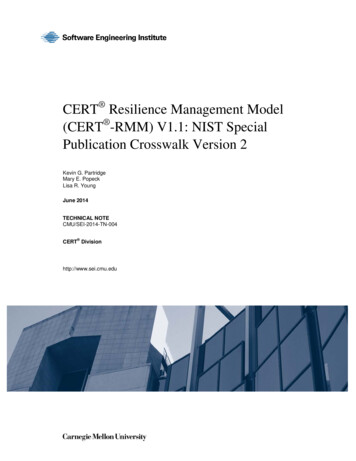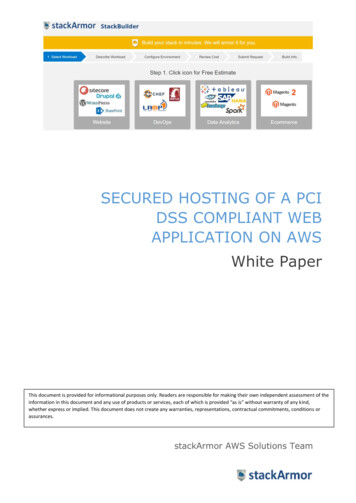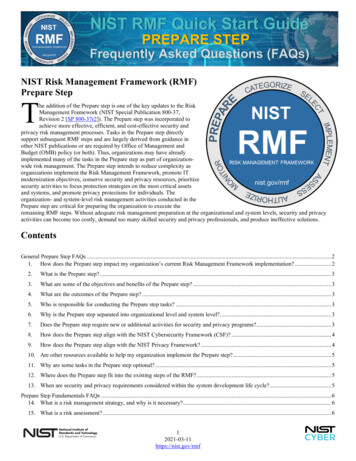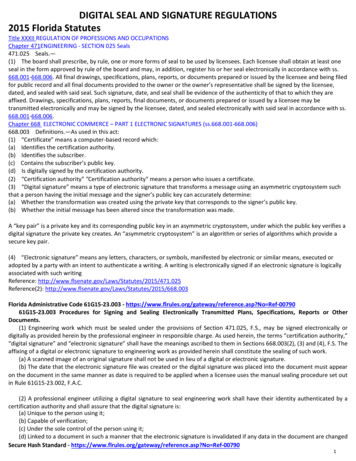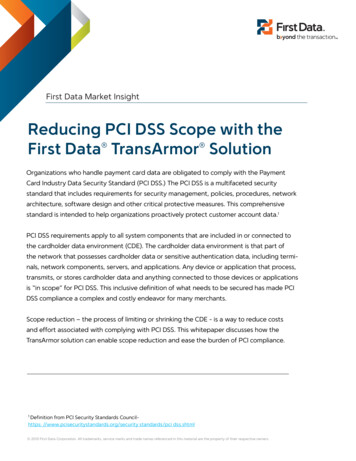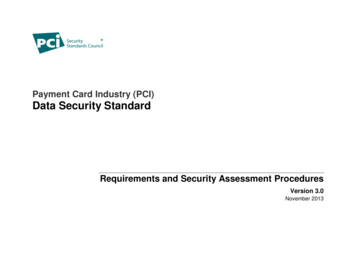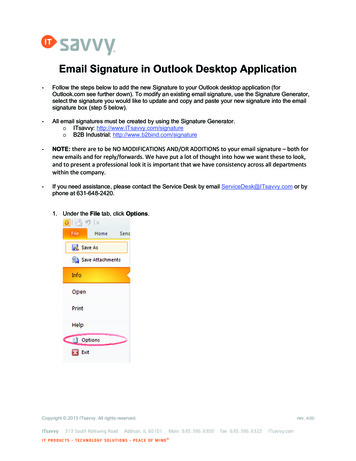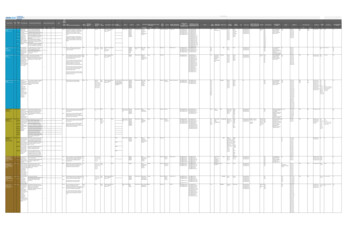
Transcription
U.S. DEPARTMENT OF COMMERCETechnology AdministrationNational Institute of Standards and TechnologyFIPS PUB 186FEDERAL INFORMATION PROCESSING STANDARDS PUBLICATIONDIGITAL SIGNATURE STANDARD (DSS)»Category:1994 May 19 0ooCD 5Q.(0CLUL468.ASA3NO.1861994Computer SecuritySubcategory:Cryptography
FIPS PUB 186FEDERAL INFORMATION PROCESSING STANDARDS PUBLICATIONDIGITAL SIGNATURE STANDARD (DSS)Category:ComputerSecurityComputer Systems LaboratoryNational Institute of Standards and TechnologyGaithersburg, MD 20899Issued May 19, 1994U.S. Department of CommerceRonald H. Brown, SecretaryTechnology AdministrationMary L. Good, Under Secretary for TechnologyNational Institute of Standardsand TechnologyArati Prabhakar, DirectorSubcategory:Cryptography
ForewordThe Federal Information Processing Standards Publication Series of the NationalInstitute of Standards and Technology (NIST) is the official publication relating tostandards and guidelines adopted and promulgated under the provisions of Section111 (d) of the Federal Property and Administrative Services Act of 1949 as amended bythe Computer Security Act of 1987, Public Law 100-235. These mandates have giventhe Secretary of Commerce and NIST important responsibilities for improving theutilization and management of computer and related telecommunications systems inthe Federal Government. The NIST, through its Computer Systems Laboratory,provides leadership, technical guidance, and coordination of Government efforts in thedevelopment of standards and guidelines in these areas.Comments concerning Federal Information Processing Standards Publications arewelcomed and should be addressed to the Director, Computer Systems Laboratory,National Institute of Standards and Technology, Gaithersburg, MD 20899.James H. Burrows, DirectorComputer Systems LaboratoryAbstractThis standard specifies a Digital Signature Algorithm (DSA) which can be used togenerate a digital signature. Digital signatures are used to detect unauthorized modifi cations to data and to authenticate the identity of the signatory. In addition, the recipi ent of signed data can use a digital signature in proving to a third party that thesignature was in fact generated by the signatory. This is known as nonrepudiationsince the signatory cannot, at a later time, repudiate the signature.Key words: ADP security; computer security; digital signatures; Federal InformationProcessing Standard; public-key cryptography.National Institute of Standardsand TechnologyFIPS PUB 18623 pages (May 19, 1994)CODEN: FIPPATU.S. Government Printing OfficeWashington: 1994For sale by the NationalTechnical InformationServiceU.S. Department of CommerceSpringfield, VA 22161
FIPS PUB 186Federal InformationProcessing Standards Publication 1861994 May 19Announcing theDIGITAL SIGNATURE STANDARD (DSS)Federal Information Processing Standards Publications (FIPS PUBS) are issued by the NationalInstitute of Standards and Technology (NIST) after approval by the Secretary of Commercepursuant to Section 111(d) of the Federal Property and Administrative Services Act of 1949 asamended by the Computer Security Act of 1987, Public Law 100-235.Name of Standard: Digital Signature Standard (DSS).Category of Standard: Computer Security, Cryptography.Explanation: This Standard specifies a Digital Signature Algorithm (DSA) appropriate forapplications requiring a digital, rather than written, signature. The DSA digital signature is a pairof large numbers represented in a computer as strings of binary digits. The digital signature iscomputed using a set of rules (i.e., the DSA) and a set of parameters such that the identity of thesignatory and integrity of the data can be verified. The DSA provides the capability to generateand verify signatures. Signature generation makes use of a private key to generate a digitalsignature. Signature verification makes use of a public key which corresponds to, but is not thesame as, the private key. Each user possesses a private and public key pair. Public keys areassumed to be known to the public in general. Private keys are never shared. Anyone can verifythe signature of a user by employing that user’s public key. Signature generation can beperformed only by the possessor of the user’s private key.A hash function is used in the signature generation process to obtain a condensed version of data,called a message digest (see Figure 1). The message digest is then input to the DSA to generatethe digital signature. The digital signature is sent to the intended verifier along with the signeddata (often called the message). The verifier of the message and signature verifies the signatureby using the sender’s public key. The same hash function must also be used in the verificationprocess. The hash function is specified in a separate standard, the Secure Hash Standard (SHS),FIPS 180. Similar procedures may be used to generate and verify signatures for stored as wellas transmitted data.1
Signature GenerationHHPMessageSignature VerificationHH fReceived Message1liSecure Hash AlgorithmSecure Hash AlgorithmMessage DigestMessage DigestPrivate1 7DSA SignOperationKeyDigital 7SignatureDigitalPublicDSA VerifyOperation 7 1Signa t ureYes-BjKeySignature VerifiedorNo - Signature Verification FailedFigure 1: Using the SHA with the DSAApproving Authority: Secretary of Commerce.Maintenance Agency: U.S. Department of Commerce, National Institute of Standards andTechnology (NIST), Computer Systems Laboratory (CSL).Applicability: This standard is applicable to all Federal departments and agencies for theprotection of unclassified information that is not subject to section 2315 of Title 10, United StatesCode, or section 3502(2) of Title 44, United States Code. This standard shall be used indesigning and implementing public-key based signature systems which Federal departments andagencies operate or which are operated for them under contract. Adoption and use of thisstandard is available to private and commercial organizations.Applications: The DSA authenticates the integrity of the signed data and the identity of thesignatory. The DSA may also be used in proving to a third party that data was actually signed2
by the generator of the signature. The DSA is intended for use in electronic mail, electronicfunds transfer, electronic data interchange, software distribution, data storage, and otherapplications which require data integrity assurance and data origin authentication.Implementations: The DSA may be implemented in software, firmware, hardware, or anycombination thereof. NIST is developing a validation program to test implementations forconformance to this standard. Information about the planned validation program can be obtainedfrom the National Institute of Standards and Technology, Computer Systems Laboratory, Attn:DSS Validation, Gaithersburg, MD 20899.Export Control: Implementations of this standard are subject to Federal Government exportcontrols as specified in Title 15, Code of Federal Regulations, Parts 768 through 799. Exportersare advised to contact the Department of Commerce, Bureau of Export Administration for moreinformation.Patents: The Department of Commerce is not aware of any patents that would be infringed bythis standard.Implementation Schedule: This standard becomes effective December 1, 1994.Specifications: Federal Information Processing Standard (FIPS 186) Digital Signature Standard(affixed).Cross Index:a. Federal Information Resources Management Regulations (FIRMR) subpart 201.20.303,Standards, and subpart 201.39.1002, Federal Standards.b. FIPS PUB 46-2, Data Encryption Standard.c. FIPS PUB 73, Guidelines for Security of Computer Applications.d. FIPS PUB 140-1, Security Requirements for Cryptographic Modules.e. FIPS PUB 171, Key Management Using ANSI X9.17.f. FIPS PUB 180, Secure Hash Standard.Qualifications: The security of a digital signature system is dependent on maintaining the secrecyof users’ private keys. Users must therefore guard against the unauthorized acquisition of theirprivate keys. While it is the intent of this standard to specify general security requirements forgenerating digital signatures, conformance to this standard does not assure that a particularimplementation is secure. The responsible authority in each agency or department shall assurethat an overall implementation provides an acceptable level of security. This standard will be3
reviewed every five years in order to assess its adequacy.Waiver Procedure: Under certain exceptional circumstances, the heads of Federal departmentsand agencies may approve waivers to Federal Information Processing Standards (FIPS). Thehead of such agency may redelegate such authority only to a senior official designated pursuantto section 3506(b) of Title 44, United States Code. Waiver shall be granted only when:a. Compliance with a standard would adversely affect the accomplishment of the mission ofan operator of a Federal computer system; orb. Cause a major adverse financial impact on the operator which is not offset byGovernment wide savings.Agency heads may act upon a written waiver request containing the information detailed above.Agency heads may also act without a written waiver request when they determine that conditionsfor meeting the standard cannot be met. Agency heads may approve waivers only by a writtendecision which explains the basis on which the agency head made with required finding(s). Acopy of each such decision, with procurement sensitive or classified portions clearly identified,shall be sent to: National Institute of Standards and Technology; ATTN: FIPS Waiver Decisions,Technology Building, Room B-154, Gaithersburg, MD 20899.In addition, notice of each waiver granted and each delegation of authority to approve waiversshall be sent promptly to the Committee on Government Operations of the House ofRepresentatives and the Committee on Governmental Affairs of the Senate and shall be publishedpromptly in the Federal Register.When the determination on a waiver applies to the procurement of equipment and/or services,a notice of the waiver determination must be published in the Commerce Business Daily as a partof the notice of solicitation for offers of an acquisition or, if the waiver determination is madeafter that notice is published, by amendment to such notice.A copy of the waiver, any supporting documents, the document approving the waiver and anysupporting and accompanying documents, with such deletions as the agency is authorized anddecides to make under 5 U.S.C. Sec. 552(b), shall be part of the procurement documentation andretained by the agency.Where to Obtain Copies of the Standard: Copies of this publication are for sale by theNational Technical Information Service, U.S. Department of Commerce, Springfield, VA 22161.When ordering, refer to Federal Information Processing Standards Publication 186 (FIPS PUB186), and identify the title. When microfiche is desired, this should be specified. Prices arepublished by NTIS in current catalogs and other issuances. Payment may be made by check,money order, deposit account or charged to a credit card accepted by NTIS.4
Federal InformationProcessing Standards Publication 1861994 May 19Specifications for theDIGITAL SIGNATURE STANDARD (DSS)1. INTRODUCTIONThis publication prescribes the Digital Signature Algorithm (DS A) for digital signature generationand verification. Additional information is provided in Appendices 1 through 5.2. GENERALWhen a message is received, the recipient may desire to verify that the message has not beenaltered in transit. Furthermore, the recipient may wish to be certain of the originator’s identity.Both of these services can be provided by the DSA. A digital signature is an electronic analogueof a written signature in that the digital signature can be used in proving to the recipient or athird party that the message was, in fact, signed by the originator. Digital signatures may alsobe generated for stored data and programs so that the integrity of the data and programs may beverified at any later time.This publication prescribes the DSA for digital signature generation and verification. In addition,the criteria for the public and private keys required by the algorithm are provided.3. USE OF THE DSA ALGORITHMThe DSA is used by a signatory to generate a digital signature on data and by a verifier to verifythe authenticity of the signature. Each signatory has a public and private key. The private keyis used in the signature generation process and the public key is used in the signature verificationprocess. For both signature generation and verification, the data which is referred to as amessage, M, is reduced by means of the Secure Hash Algorithm (SHA) specified in FIPS 180.An adversary, who does not know the private key of the signatory, cannot generate the correctsignature of the signatory. In other words, signatures cannot be forged. However, by using thesignatory’s public key, anyone can verify a correctly signed message.5
A means of associating public and private key pairs to the corresponding users is required. Thatis, there must be a binding of a user’s identity and the user’s public key. This binding may becertified by a mutually trusted party. For example, a certifying authority could sign credentialscontaining a user’s public key and identity to form a certificate. Systems for certifyingcredentials and distributing certificates are beyond the scope of this standard. NIST intends topublish separate document(s) on certifying credentials and distributing certificates.4. DSA PARAMETERSThe DSA makes use of the following parameters:1. p a prime modulus, where 2L'! p 2L for 512 L 1024 and L a multiple of 642. q a prime divisor of p - 1, where 2159 q 21603. g h(p"1)/q mod p, where h is any integer with 1 h p - 1 such that h(p 1)/q mod p 1(g has order q mod p)4. x a randomly or pseudorandomly generated integer with 0 x q5. y gx mod p6. k a randomly or pseudorandomly generated integer with 0 k qThe integers p, q, and g can be public and can be common to a group of users. A user’s privateand public keys are x and y, respectively. They are normally fixed for a period of time.Parameters x and k are used for signature generation only, and must be kept secret. Parameterk must be regenerated for each signature.Parameters p and q shall be generated as specified in Appendix 2, or using other FIPS approvedsecurity methods. Parameters x and k shall be generated as specified in Appendix 3, or usingother FIPS approved security methods.5. SIGNATURE GENERATIONThe signature of a message M is the pair of numbers r and s computed according to the equationsbelow:r (gk mod p) mod qands (k 1(SHA(M) xr)) mod q.6
In the above, k'1 is the multiplicative inverse of k, mod q; i.e., (k1 k) mod q 1 and 0 k'1 q. The value of SHA(M) is a 160-bit string output by the Secure Hash Algorithm specified inFIPS 180. For use in computing s, this string must be converted to an integer. The conversionrule is given in Appendix 2.2.As an option, one may wish to check if r 0 or s 0. If either r 0 or s 0, a new value ofk should be generated and the signature should be recalculated (it is extremely unlikely that r 0 or s 0 if signatures are generated properly).The signature is transmitted along with the message to the verifier.6. SIGNATURE VERIFICATIONPrior to verifying the signature in a signed message, p, q and g plus the sender’s public key andidentity are made available to the verifier in an authenticated manner.Let M', r', and s' be the received versions of M, r, and s, respectively, and let y be the public keyof the signatory. To verify the signature, the verifier first checks to see that 0 r' q and 0 s' q; if either condition is violated the signature shall be rejected. If these two conditions aresatisfied, the verifier computesw (s')'1 mod qul ((SHA(MO)w) mod qu2 ((r')w) mod qv (((g)ul (y)u2) mod p) mod q.If v r', then the signature is verified and the verifier can have high confidence that the receivedmessage was sent by the party holding the secret key x corresponding to y. For a proof that v r' when M' M, r' r, and s' s, see Appendix 1.If v does not equal r', then the message may have been modified, the message may have beenincorrectly signed by the signatory, or the message may have been signed by an impostor. Themessage should be considered invalid.7
APPENDIX 1. A PROOF THAT v r'This appendix is for informational purposes only and is not required to meet the standard.The purpose of this appendix is to show that if M' M, x r and s' s in the signatureverification then v x. We need the following easy result.LEMMA. Let p and q be primes so that q divides p - l,ha positive integer less than p, and gh(p 1)/q mod p. Then gq mod p 1, and if m mod q n mod q, then gm mod p gn mod p.Proof: We havegq mod p (h pl)/q mod p)q mod p h(p l) mod p 1by Fermat’s Little Theorem. Now let m mod q n mod q, i.e., m n kq for some integer k.Thengra mod p gn kq mod p (g“ gkq) mod p ((gn mod p) (gq mod p)k) mod p gn mod psince gq mod p 1. We are now ready to prove the main result.THEOREM. If M' M, r' r, and s' s in the signature verification, then v r'.Proof: We havew (s')'1 mod q s'1 mod qul ((SHA(MO)w) mod q ((SHA(M))w) mod qu2 ((r')w) mod q (rw) mod q.8
Now y g* mod p, so that by the lemma,v ((gul yu2) mod p) mod q ((gSHA M w y ) mod p) mod q gxrw) mod p) mod q ((g( HA(M xr)w} m()d p) mQd qAlsos (k SHACM) xr)) mod q.Hencew (k(SHA(M) xr)'1) mod q(SHA(M) xr)w mod q k mod q.Thus by the lemma,v (gk mod p) mod q r r'. 9
APPENDIX 2. GENERATION OF PRIMES FOR THE DSAThis appendix includes algorithms for generating the primes p and q used in the DSA. Thesealgorithms require a random number generator (see Appendix 3), and an efficient modularexponentiation algorithm. Generation of p and q shall be performed as specified in this appendix,or using other FIPS approved security methods.2.1. A PROBABILISTIC PRIMALITY TESTIn order to generate the primes p and q, a primality test is required.There are several fast probabilistic algorithms available. The following algorithm is a simplifiedversion of a procedure due to M.O. Rabin, based in part on ideas of Gary L. Miller. [See Knuth,The Art of Computer Programming, Vol. 2, Addison-Wesley, 1981, Algorithm P, page 379.] Ifthis algorithm is iterated n times, it will produce a false prime with probability no greater thanl/4n. Therefore, n 50 will give an acceptable probability of error. To test whether an integeris primesStep 1. Set i 1 and n 50.Step 2. Set w the integer to be tested, w 1 2am, where m is odd and 2a is the largestpower of 2 dividing w - 1.Step 3. Generate a random integer b in the range 1 b w.Step 4. Set j 0 and z bni mod w.Step 5. If j 0 and z 1, or if z w - 1, go to step 9.Step 6. If j 0 and z 1, go to step 8.Step 7. j j 1. If j a, set z z2 mod w and go to step 5.Step 8. w is not prime. Stop.Step 9. If i n, set i i 1 and go to step 3. Otherwise, w is probably prime.2.2. GENERATION OF PRIMESThe DSS requires two primes, p and q, satisfying the following three conditions:a. 2159 q 2,6 b. 2L1 p 2L for a specified L, where L 512 64j for some 0 j 810
c. q divides p - 1.This prime generation scheme starts by using the SHA and a user supplied SEED to constructa prime, q, in the range 2159 q 2160. Once this is accomplished, the same SEED value is usedto construct an X in the range 2L1 X 2L. The prime, p, is then formed by rounding X to anumber congruent to 1 mod 2q as described below.An integer x in the range 0 x 2g may be converted to a g-long sequence of bits by using itsbinary expansion as shown below:x x1*2g'1 x2*28'2 . xg.,*2 xg - { Xi„.,xg }.Conversely, a g-long sequence of bits { x,,.,xg } is converted to an integer by the rule{ x„.,xg } - x1*2g‘1 x2*2g‘2 . xg.j*2 xg.Note that the first bit of a sequence corresponds to the most significant bit of the correspondinginteger and the last bit to the least significant bit.Let L - 1 n*160 b, where both b and n are integers and 0 b 160.Step 1. Choose an arbitrary sequence of at least 160 bits and call it SEED. Let g be the lengthof SEED in bits.Step 2. ComputeU SHA[SEED] XOR SHA[(SEED 1) mod 2g ].Step 3. Form q from U by setting the most significant bit (the 2159 bit) and the least significantbit to 1. In terms of boolean operations, q U OR 2159 OR 1. Note that 2159 q 2160.Step 4. Use a robust primality testing algorithm to test whether q is prime1.Step 5. If q is not prime, go to step 1.Step 6. Let counter 0 and offset 2.Step 7. For k 0,.,n letVk SHA[(SEED offset k) mod 2g ].*A robust primality test is one where the probability of a non-prime number passing the test isat most 2'80.11
Step 8. Let W be the integerW V0 V,*2160 . Vn 1*2(n'1)*160 (Vn mod 2b) * 2n‘160and let X W 2L1. Note that 0 W 2L1 and hence 2L 1 X 2L.Step 9. Let c X mod 2q and set p X - (c - 1). Note that p is congruent to 1 mod 2q.Step 10. If p 2L'\ then go to step 13.Step 11. Perform a robust primality test on p.Step 12. If p passes the test performed in step 11, go to step 15.Step 13. Let counter counter 1 and offset offset n 1.Step 14. If counter 212 4096 go to step 1, otherwise (i.e. if counter 4096) go to step 7.Step 15. Save the value of SEED and the value of counter for use in certifying the propergeneration of p and q.12
APPENDIX 3. RANDOM NUMBER GENERATION FOR THE DSAAny implementation of the DSA requires the ability to generate random or pseudorandomintegers. Such numbers are used to derive a user’s private key, x, and a user’s per messagesecret number, k. These randomly or pseudorandomly generated integers are selected to bebetween 0 and the 160-bit prime q (as specified in the standard). They shall be generated by thetechniques given in this appendix, or using other FIPS approved security methods.One FIPS approved pseudorandom integer generator is supplied in Appendix C of ANSI X9.17,"Financial Institution Key Management (Wholesale)."Other pseudorandom integer generators are given in this appendix. These permit generation ofpseudorandom values of x and k for use in the DSA. The algorithm in section 3.1 may be usedto generate values for x. An algorithm for k and r is given in section 3.2. The latter algorithmallows most of the signature computation to be precomputed without knowledge of the messageto be signed.The algorithms employ a one-way function G(t,c), where t is 160 bits, c is b bits (160 b 512)and G(t,c) is 160 bits. One way to construct G is via the Secure Hash Algorithm (SHA), asdefined in the Secure Hash Standard (SHS). The 160-bit message digest output of the SHAalgorithm when message M is input is denoted by SHA(M). A second method for constructingG is to use the Data Encryption Standard (DES). The construction of G by these techniques isdiscussed in sections 3.3 and 3.4 of this appendix.In the algorithms in sections 3.1 and 3.2, a secret b-bit seed-key is used. The algorithm insection 3.1 optionally allows the use of a user provided input. If G is constructed via the SHAas defined in section 3.3, then b is between 160 and 512. If DES is used to construct G asdefined in section 3.4, then b is equal to 160.3.1. ALGORITHM FOR COMPUTING m VALUES OF xLet x be the signer’s private key. The following may be used to generate m values of x:Step 1. Choose a new, secret value for the seed-key, XKEY.Step 2. In hexadecimal notation lett 67452301 EFCDAB89 98BADCFE 10325476 C3D2E1F0.This is the initial value for H0 II Hj II H2 II H3 II H4 in the SHS.Step 3. For j 0 to m - 1 doa. XSEEDj optional user input.13
b. XVAL (XKEY XSEEDp mod 2b.c. Xj G(t,XVAL) mod q.d. XKEY (1 XKEY Xj) mod 2b.3.2. ALGORITHM FOR PRECOMPUTING ONE OR MORE k AND r VALUESThis algorithm can be used to precompute k, k'1, and r for m messages at a time. Algorithm:Step 1. Choose a secret initial value for the seed-key, KKEY.Step 2. In hexadecimal notation lett EFCDAB89 98BADCFE 10325476 C3D2E1F0 67452301.This is a cyclic shift of the initial value for H0 II H, II H2 II H3 II H4 in the SHS.Step 3. For j 0 to m - 1 doa. k G(t,KKEY) mod q.b. Compute Iq1 k'1 mod q.c. Compute q (gk mod p) mod q.d. KKEY (1 KKEY k) mod 2b.Step 4. Suppose Mo , . , Mn) , are the next m messages. For j 0 to m - 1 doa. Let h SHA(Mj).b. Let Sj (kj' h xq)) mod q.c. The signature for Mj is (q,Sj).Step 5. Let t h.Step 6. Go to step 3.Step 3 permits precomputation of the quantities needed to sign the next m messages. Step 4 canbegin whenever the first of these m messages is ready. The execution of step 4 can be suspendedwhenever the next of the m messages is not ready. As soon as steps 4 and 5 have completed,step 3 can be executed, and the results saved until the first member of the next group of m14
messages is ready.In addition to space for KKEY, two arrays of length m are needed to store r0 , . r and ko *,. , k f1 when they are computed in step 3. Storage for s0 , . , sra.! is only needed if thesignatures for a group of messages are stored; otherwise Sj in step 4 can be replaced by s and asingle space allocated.3.3. CONSTRUCTING THE FUNCTION G FROM THE SHAG(t,c) may be constructed using steps (a) - (e) in section 7 of the Specifications for the SecureHash Standard. Before executing these steps, {Hj} and Mj must be initialized as follows;i. Initialize the {Hj} by dividing the 160 bit value t into Five 32-bit segments as follows;t to II tj IIII t3 II t4Then Hj tj for j 0 through 4.ii. There will be only one message block, M,, which is initialized as follows;M, c II 0512 b(The first b bits of M, contain c, and the remaining (512-b) bits are set to zero).Then steps (a) through (e) of section 7 are executed, and G(t,c) is the 160 bit string representedby the five words;H0 II H, II H2 II H3 II H4at the end of step (e).3.4. CONSTRUCTING THE FUNCTION G FROM THE DESLet a XOR b denote the bitwise exclusive-or of bit strings a and b. Suppose al, a2, bl, b2 are32-bit strings. Let bl’ be the 24 least significant bits of bl. Let K bl’ II b2 and A al II a2.DefineDESbl b2(al,a2) DESK(A)In the above, DESK(A) represents ordinary DES encryption of the 64-bit block A using the 56-bitkey K. Now suppose t and c are each 160 bits. To compute G(t,c):Step 1. Write15
t tj II II t3 II t4 II t5In the above, each t, and c; is 32 bits.Step 2. For i 1 to 5 dox, XOR c,Step 3. For i 1 to 5 dob 1 — C((i 3) mod 5) 1b2 — c((j 2) mod 5) al x, (i mod 5) 1XORYu II yw DESblb2(al,a2)m(Mj 5) j(yu, yi2 : 32 bits)Step 4. For i 1 to 5 dozi yi.i XOR y((i 1) mod 5 1,2 XOR y((i 2) mod 5) l.lStep 5. LetG(t,c) Zj II z2 II z3 II z4 II z516
APPENDIX 4. GENERATION OF OTHER QUANTITIESThis appendix is for informational purposes only and is not required to meet the standard.The algorithms given in this appendix may be used to generate the quantities g, k'\ and s'1 usedin the DSS.To generate g:Step 1. Generate p and q as specified in Appendix 2.Step 2. Let e (p - l)/q.Step 3. Set h any integer, where 1 h p - 1 and h differs from any value previously tried.Step 4. Set g he mod p.Step 5. If g 1, go to step 3.To compute the multiplicative inverse n'1 mod q for n with 0 n q, where 0 n'1 q:Step 1. Set i q, h n, v 0, and d 1.Step 2. Let t i DIV h, where DIV is defined as integer division.Step 3. Set x h.Step 4. Set h i - tx.Step 5. Set i x.Step 6. Set x d.Step 7. Set d v - tx.Step 8. Set v x.Step 9. If h 0, go to step 2.Step 10. Let n'1 v mod q.Note that in step 10, v may be negative. The v mod q operation should yield a value between1 and q - 1 inclusive.17
APPENDIX 5. EXAMPLE OF THE DSAThis appendix is for informational purposes only and is not required to meet the standard.Let L 512 (size of p). The values in this example are expressed in hexadecimal notation. Thep and q given here were generated by the prime generation standard described in appendix 2using the 160-bit SEED:d5014e4b60ef2ba8b6211b4062ba3224e0427dbdWith this SEED, the algorithm found p and q when the counter was at 38.x was generated by the algorithm described in appendix 3, section 3.1, using the SHA toconstruct G (as in appendix 3, section 3.3) and a 160-bit XSEED:XSEED CDAB8998BADCFE10325476C3D2E1F0x G(t,XSEED) mod qk was generated by the algorithm described in appendix 3, section 3.2, using the SHA toconstruct G (as in appendix 3, section 3.3) and a 160-bit KSEED:KSEED BADCFE10325476C3D2E1F067452301k G(t,KSEED) mod qFinally:h 218
p 49a9e7cd781d21 726ecc751eface254454263e9023q g 07e7adaf23bbecc4x k kinv 2784e3d6M ASCII form of "abc" (See FIPS PUB YY, Appendix A)SHA(M) 849b77f7054c81531c4e46a4692fbfe0f77f7ebff2y r 19flc4f726e94d3725
cd8c5e44ccf4fbl9bec893a39ddf9767e4a678
This standard specifies a Digital Signature Algorithm (DSA) which can be used to generate a digital signature. Digital signatures are used to detect unauthorized modifi cations to data and to authenticate the identity of the signatory. In addition, the recipi ent of signed data can use a digital signature in proving to a third party that the
